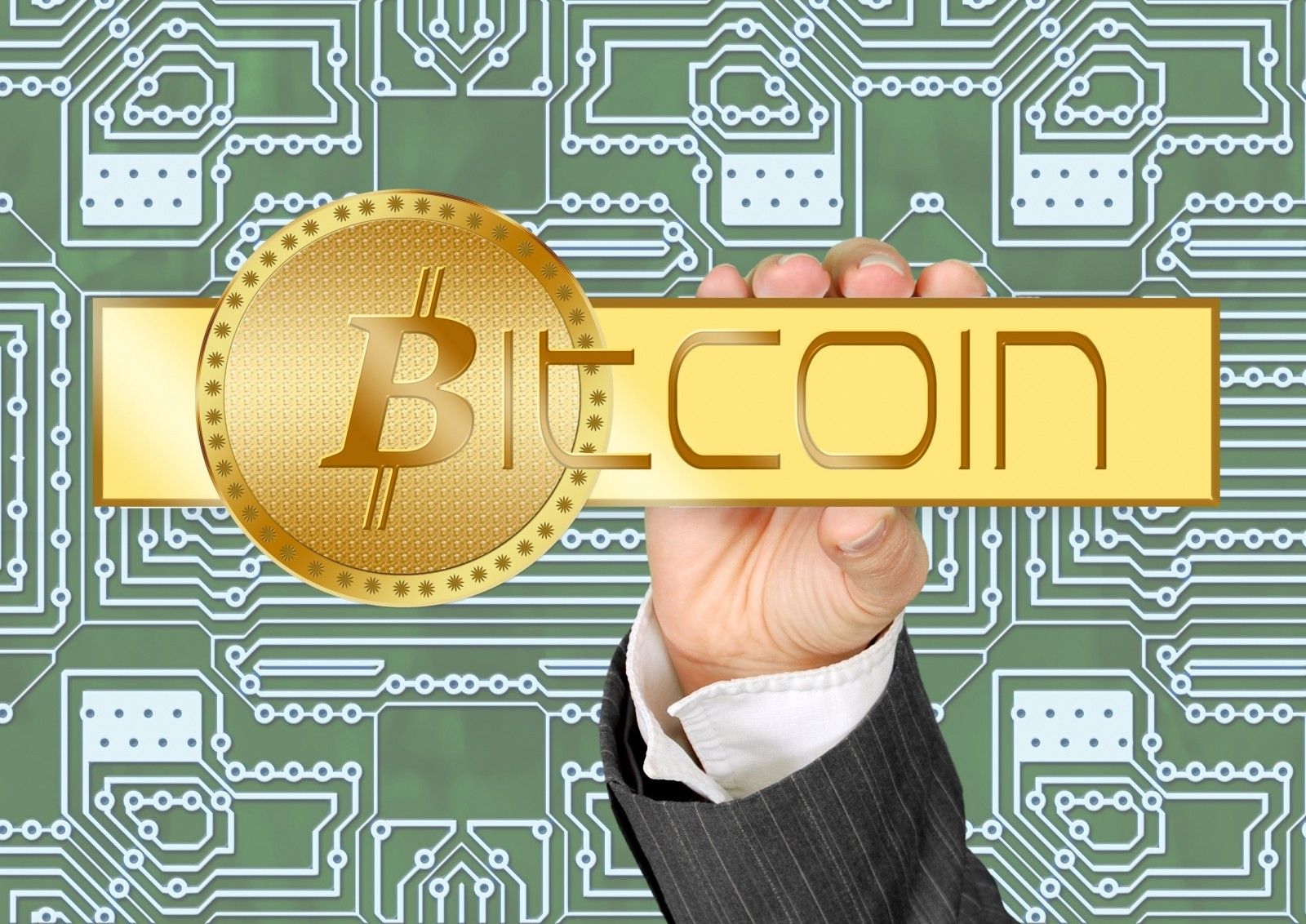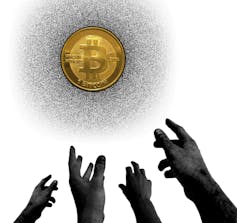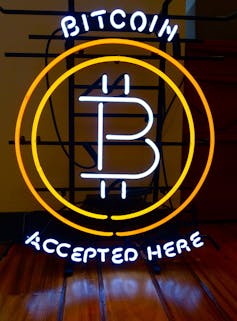Bitcoin: the economic issues at stake
Patrick Waelbroeck, Institut Mines-Télécom (IMT)
[divider style=”normal” top=”20″ bottom=”20″]
[dropcap]C[/dropcap]ryptocurrencies like Bitcoin only have value if all the participants in the monetary system view it to as currency. It must therefore be rare, in the sense that it must not be easily copied (a problem equivalent to counterfeit banknotes for traditional currencies).
This is a requirement that is met by the Bitcoin network, which ensures no double-spending occurs. In addition to the value linked to the acceptance of the currency, Bitcoins owes its value to a variety of economic mechanisms linked to the analysis of the Bitcoins’ supply and demand.
Bitcoin supply
The issuance of currency in the primary market
The creation of Bitcoins is determined by the mining process. Each block that is mined generates Bitcoins. Their design stipulates that the amount per mined block be divided by 2 for every 210,000 blocks, to obtain a total amount of Bitcoins in circulation of (excluding those that are lost) 21 million. This monetary rule is monitored by the Bitcoin Foundation consortium, as we will discuss later in this article. The monetary rule can therefore be modified to respond to fluctuating market conditions, which can result in a hard fork.
Electricity is the main component (over 90% according to current estimates) of a mining farm’s total costs. In 2015, Böhme et al. (2015) assessed the Bitcoin network’s consumption at over 173 megawatts of electricity on a continuous basis. This represented approximately 20% of a nuclear power plant’s production and amounted to 178 million dollars per year (based on residential electricity prices in the United States). This amount may seem high, but Pierre Noizat considers that it is not any more than the annual electricity cost for the global network of ATMs (automatic teller machines), estimated at 400 megawatts. Once we figure in the costs involved in manufacturing and putting currency and bank cards into circulation, we see that the Bitcoin network’s electricity cost is not as high as it seems.
However, this cost may significantly increase as the network continues to develop, due to a negative externality inherent in mining: each miner that invests in new material increases his or her marginal revenue, but at the same time increases the overall mining cost, since the difficulty increases with the number of miners and their computation capacity (hash power).
La quête du bitcoin. xlowmiller/VisualHunt
Therefore, for the Bitcoin network, the difficulty of the cryptography problem that must be solved and approved by a proof-of-work consensus increases along with the network’s overall hash power. There is therefore a risk of over-investing in the mining capacity, since individual miners do not consider the negative effect on the entire network.
It is important to note that increasing the mining difficulty reduces mining incentives and increases the verification time, and thus the efficiency of the blockchain itself. This mechanism brings to mind the tragedy of the commons, in which shared resources (here, hash power) are depleted and only maintained by a handful of farms and pools, thereby nullifying the very principle of the public blockchain, which is decentralized.
There is therefore a risk that mining capacities will become greatly concentrated in the hands of a small group of players, thus invalidating the very principle of the blockchain. This trend is already visible today.
In the end, the supply of Bitcoins, and therefore the monetary creation on the primary market, depend on the cost of electricity and the difficulty associated with the mining process, as well as the governance rules pertaining to the Bitcoin price generated by a mined block.
The Bitcoins value on the secondary market
The Bitcoin can also be bought and sold on an exchange platform. In this case, the Bitcoin’s value is similar to a financial investment in which the financial players anticipate the prospect of financial gain and factors that could cause the Bitcoin to appreciate.
Bitcoin demand
The demand for cryptocurrency depends on several user concerns that are addressed below, starting with the positive factors and ending with the risks.
Financial privacy
Bitcoin accepted here. jurvetson on Visual Hunt
Governments are increasingly limiting the use of cash to demonstrate their efforts to counter money-laundering and the development of black markets. Cash is the only means of payment that is 100% anonymous. Bitcoin and other cryptocurrencies come in second, since the pseudonymous system used by Bitcoin effectively conceals the identity of the individuals making the transactions. Furthermore, other cryptocurrencies, such as the Zcash, go a step further, masking all the metadata linked to a transaction.
Why do people want to use an anonymous payment method? For several reasons.
First of all, this type of payment method prevents users from leaving any traces that could be used for monitoring purposes by the government, employers, and certain companies (especially banks and insurance companies). Companies and banks use price discrimination practices that can sometimes work against consumers. Leaving traces through payment can also cause companies to further incite customers to take advantage of new commercial offers and engage in targeted advertising that some see as a nuisance.
Secondly, paying with an anonymous payment method limits “sousveillance” (or inverse-surveillance) by close friends and family. Like when a payment is made using a joint account.
Thirdly, making payment under a pseudonym makes it possible to maintain business confidentiality.
Fourthly, just like the privacy policy, anonymity in certain transactions (for example healthcare products or hospital visits) helps build trust in society, and is therefore of economic value. Therefore, by enabling pseudonymity, Bitcoin brings added value in these various instances.
The Bitcoin works in times of crisis, thus avoiding capital controls
The Bitcoin emerged right after the financial crisis of 2008. This period witnessed the power of governments and central banks to control cash withdrawals and outstanding capital stock. There are very few means available for avoiding these two institutional constraints. The Bitcoin in one such means. Even if cash withdrawals are prohibited, Bitcoin owners can still pay using their private key.
The Bitcoin imposes discipline on governments
The Bitcoin (and the same is true for other cryptocurrencies) can be considered as a monetary alternative that is not controlled by a central bank. Some economists, like F. Hayek, sees these alternative currencies that compete with the official currency as a means of imposing discipline on governments that might be tempted to use inflation to finance their debt. If this happens, consumers and investors would no longer use the official currency, and would instead purchase the alternative currency, creating a deflationary pressure on the official currency.
Security-related network externalities
The level of security increases with the number of network nodes, since each node increases the computation power required to create a breach in the Blockchain security (through a 51% attack, double-spending, or denial of service–DOS). Furthermore, a DOS attack is especially hard to stage, since it is so difficult to determine who the recipient is. Positive network externalities therefore exist: Bitcoin’s value increases with the number of nodes participating in the network.
Indirect network externalities related to payment method
Bitcoin is a payment method, just like cash, debit cards and Visa/Mastercard/American Express cards. Bitcoin can therefore be understood using the multi-sided market theory, which models situations where two groups of economic players benefit from positive crossed externalities. The consumer who chooses a payment method for a purchase is happy when it is accepted by the merchant. In the same way, merchants are eager to accept a payment method that customers possess. Consequently, the dynamics of multi-sided markets result in virtuous cycles that can experience a slow inception phase, followed by a very fast deployment phase. If the Bitcoin experienced this type of phase, its value would enter a period of acceleration.
A Bitcoin bubble? duncan on Visual Hunt, CC BY-NC
The risks
Among the factors that reduce the demand for Bitcoins, the most prominent are the risks related to rules and regulations. On the one hand, a State could order that the capital gains generated from buying and selling Bitcoins be declared. On the other hand, Bitcoins can be used in regulated sectors (like the insurance and bank sectors) and their use could therefore be regulated as well. Finally, there is always the risk of losing the data on the hard drive where the private key is stored, resulting in the loss of the associated Bitcoins, or a State could force access to private keys for security reasons.
However, the greatest risk involves the governance of the Bitcoin network.
In the event of a disagreement on how the communication protocol should develop, there is a risk that the network could split into several networks (hard fork) with currencies that would be incompatible with each other. The most important issue involves the choice of the consensus rule for validating new blocks. A consensus must be reached on this consensus, which the technology itself appears unable to provide.
Conclusion
The Bitcoin’s economic value depends on many positive economic factors that could propel the cryptocurrency into a period of sustained growth, which would justify the current surge in its prices in the exchange markets. However, the risks related to the network’s governance must not be overlooked, since trust in this new currency depends on it.
Patrick Waelbroeck, Professor of Economics at Télécom ParisTech, Institut Mines-Télécom (IMT)
The original version of this article (in French) was published on The Conversation.
Also read on I’MTech:







Leave a Reply
Want to join the discussion?Feel free to contribute!